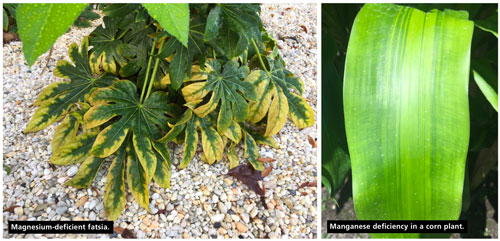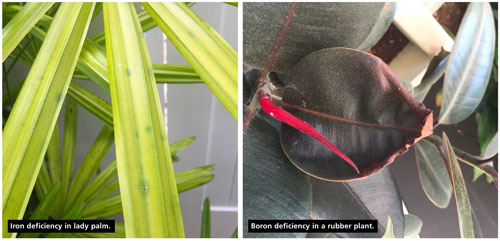11/1/2022
Nutritional Tips for Tropical Foliage Plants
Lynn Griffith

While the tropical foliage varieties we produce for the houseplant market are native to all continents except Antarctica, I have some general and specific tips for supplying their nutritional needs. Most foliage plants in 6-in. or smaller containers are fertilized with soluble fertilizers, often 20-10-20 or similar. Many growers have shifted to soluble 15-5-15 or 17-5-17 Cal Mag formulations. Most 20-10-20 versions contain no calcium or sulfur and very little magnesium. Lack of sulfur in the program can be especially a problem for ferns and arboricolas.
Foliage plants in 8-in. or larger pots today are generally grown with controlled release fertilizers (CRF). With labor costs and availability issues, many growers use these longer-term fertilizers to avoid having to do follow-up top dresses. These controlled release products can be incorporated into the media or top dressed. Both techniques work well.
However, it can be tricky to calibrate the longevity of the CRF with the crop production time. Seasonal factors come into play, but there’s another wrinkle. Some CRF products peg their release curves to a 70-degree soil temperature. Others calibrate to 86 degrees. In cooler climates, the real longevity may be longer than what it says on the bag. In hot climates, it may be significantly shorter. Establishing the true longevity of your CRF in your environment is critical.
Micronutrients are sometimes incorporated into the potting media. Other times the CRF should contain adequate minors. Foliar sprays of micronutrients and magnesium are often used in foliage production. Foliage tends to have thinner and softer leaves as opposed to woody ornamentals. Therefore, they’re generally more able to absorb foliar nutrition than woodies and trees.
Speaking of magnesium, many tropicals have high magnesium requirements. Among them are spathiphyllum, anthurium, pothos, ginger, heliconia, some ficus and many palms. The primary function of magnesium in plants is that it’s in the middle of the chlorophyll molecule. When plants run low on magnesium, they steal it from the old leaves and move it into the new leaves. You then have a lack of magnesium and thus a lack of chlorophyll in the margins of the older leaves.
Magnesium deficiencies are fairly easily corrected with sprays or drenches of magnesium sulfate, magnesium chelates or magnesium nitrate. I prefer magnesium nitrate, as it’s a more direct precursor of chlorophyll. Also, any stock plant is going to require more magnesium than a production plant. The constant pruning of stock plants removes a lot of magnesium. In fact, any plant that you prune may require extra magnesium.
Palms often show signs of potassium deficiency in the form of necrotic spots or tip burn in the older fronds. The newer fronds normally look fine. The reason is that potassium is involved in the function of the guard cells, which regulate the opening and closing of the stomates. When a palm is deficient in potassium, it can’t “close the window” when the palm is stressed by heat, drought, salts or low humidity. The necrotic spots can often be confused with foliar diseases.
Potassium is very leachable in potting media. Having coated, slow-release potassium can help prevent potassium deficiency. So can regular soluble or liquid fertilization. Foliar sprays of potassium nitrate or similar can help some, though most palms aren’t very efficient absorbers of foliar nutrition. Once the necrotic spots form in the older fronds, correcting the potassium deficiency won’t make the spots go away.
Plants, including tropicals, generally need significantly less phosphorus than nitrogen or potassium. However, a few factors need to be considered:
1. Most potting media ingredients are deficient in available phosphorus.
2. Plants especially need phosphorus early in production to establish an abundant root system.
3. Phosphorus tends to leach from most potting media. Symptoms of phosphorus deficiency aren’t very common, though you may see it in some dracaena varieties. It shows up as a reddish or purple color in the older leaves.
Most foliage plants require roughly a 3-1-2 ratio of N-P2O5-K2O. Since we’re often growing plants for their attractive foliage rather than flowers, we tend to push the plants for vegetative growth with significant amounts of nitrogen fertilizer. Many growers will also spray with urea, calcium nitrate or potassium nitrate in order to speed growth and shorten production time.
 Calcium deficiencies tend to appear in older crops when the dolomite in the media has been depleted. Symptoms may appear as weak, droopy growth, or distorted or twisted leaves. Bird of paradise, both orange and white, are especially susceptible to calcium deficiency. So are aspidistras. Sprays or drenches with calcium nitrate or a calcium chelate will often alleviate the symptoms, though the distorted leaves will remain distorted.
Calcium deficiencies tend to appear in older crops when the dolomite in the media has been depleted. Symptoms may appear as weak, droopy growth, or distorted or twisted leaves. Bird of paradise, both orange and white, are especially susceptible to calcium deficiency. So are aspidistras. Sprays or drenches with calcium nitrate or a calcium chelate will often alleviate the symptoms, though the distorted leaves will remain distorted.
Some experts believe that pH in container media doesn’t matter. I’ve come to learn that it really depends on the plant variety. Aglaonemas don’t seem to care. They grow fine at a pH 4 or pH 8. With other plants, if you aren’t in a particular pH range, which can be somewhat narrow, you’ll have problems. Crotons and arboricolas don’t do well in low pH situations. Majesty palms are acid-loving plants with very high nutrient requirements.
In the realm of micronutrient deficiencies, lack of iron is the most common in foliage, followed by manganese, boron, zinc, copper and molybdenum. As with most plants, iron deficiency will appear as interveinal chlorosis in the new leaves. Susceptible varieties include Dracaena Janet Craig, Norfolk Island pine, grape ivy, gardenia, hibiscus and China doll. Palms more susceptible to iron deficiency include areca, rhapis, majesty and Chinese fan.
Some foliage plants absorb iron from foliar sprays better than others. For example, I’ve never been able to get hibiscus to absorb foliar iron. You have to go through the soil via a drench or a granular iron topdress. If you spray iron or a micronutrient blend on a deficient foliage plant, you may see what I call “green dots of absorption.” These are localized areas where foliar iron has been absorbed, giving you green spots in otherwise chlorotic leaves. If you see this symptom, you know iron is deficient. No other nutrient does this in my experience.
Also, some varieties absorb different chelating agents with different affinities. For example, aglaonemas don’t absorb DTPA chelates very well, but they do absorb EDDHA chelates. Glucoheptonate chelates are excellent general-purpose sources for foliage plants.
Manganese deficiency looks a lot like iron deficiency. I see it a lot in Ficus lyrata, marginatas and massangeanas and some palms. Sprays with manganese sulfate or a manganese chelate will usually correct it, though it may take several applications.
Lack of boron can show up in anthurium, corn plant, ficus, spathiphyllum and others. Sprays with Solubor or borax should easily correct the situation. Deficiencies of the other micronutrients are fairly rare in foliage. Marginatas will often suffer from copper or zinc deficiencies. Lack of copper appears as a hard brittle spear leaf. Low zinc gives you small leaves. GT
Lynn Griffith is a tropical plant and soil expert residing in Boca Raton, Florida.